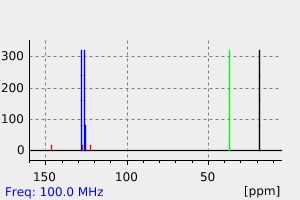1-Isopropylidene-3-phenylcyclobutane | 146514-41-2
中文名称
——
中文别名
——
英文名称
1-Isopropylidene-3-phenylcyclobutane
英文别名
(3-Propan-2-ylidenecyclobutyl)benzene
CAS
146514-41-2
化学式
C13H16
mdl
——
分子量
172.27
InChiKey
WBNDNAIPGIFCCM-UHFFFAOYSA-N
BEILSTEIN
——
EINECS
——
-
物化性质
-
计算性质
-
ADMET
-
安全信息
-
SDS
-
制备方法与用途
-
上下游信息
-
文献信息
-
表征谱图
-
同类化合物
-
相关功能分类
-
相关结构分类
物化性质
-
沸点:228.8±15.0 °C(Predicted)
-
密度:0.973±0.06 g/cm3(Predicted)
计算性质
-
辛醇/水分配系数(LogP):3.6
-
重原子数:13
-
可旋转键数:1
-
环数:2.0
-
sp3杂化的碳原子比例:0.38
-
拓扑面积:0
-
氢给体数:0
-
氢受体数:0
上下游信息
-
上游原料
中文名称 英文名称 CAS号 化学式 分子量 3-苯基环丁酮 3-Phenylcyclobutanone 52784-31-3 C10H10O 146.189
反应信息
-
作为反应物:描述:参考文献:名称:Preparation and Photosensitized Oxidation of Isopropylidenecyclobutanes and -cyclobutenes摘要:Isopropylidenecyclobutanes 2-5 underwent facile ene reaction with singlet dioxygen, yielding (upon Ph(3)P reduction) the corresponding pairs of epimeric allylic alcohols 9 and 10, 11 and 12, 13 and 14, and 15 and 16, respectively. A combination of spectral evidence and molecular modeling studies were utilized in the structural assignment of the epimers. The data clearly indicate that steric considerations play an important role in determining the face of the ring which O-1(2) approaches. Isopropylidenecyclobutenes 6 and 7 reacted with singlet oxygen more slowly than their monoolefinic analogs, yielding upon reduction allylic alcohols 21b and 22, respectively. Benzo analog 7 also generated a small and solvent-dependent amount of isomeric aldehydes 23 and 24, presumably via a free-radical mechanism. n-Butyl diene 8 underwent rapid photosensitized oxygenation producing allylic alcohol 35 (as the O-1(2) ene product) and dione 37 (the Hock-cleavage product of allylic hydroperoxide 39, formed in turn via a free-radical route) in a 1:9 ratio. Ah initio (STO-3G) calculations confirm that, in their lowest energy conformations, compounds 2-8 are planar with the methylene ring hydrogens displaced ca. 36 degrees from the perpendicular. As a result, only exocyclic ene product is formed, since O-1(2) strongly prefers axial or pseudoaxial allylic hydrogens. These calculations combined with the relative rate data suggest that the initial interaction between the electrophilic O-1(2) and alkylidenecyclobutenes involves both ends of the singlet dioxygen molecule, in which the ''front'' end attacks the reactive exocyclic double bond while the ''back'' end obtains stabilization by interacting with the more electron rich but unreactive endocyclic olefin linkage. Because of this added, and presumably substantial, stabilization, the relative rates within this system are determined in part by the orbital coefficients at the latter olefinic center.DOI:10.1021/jo00083a019
-
作为产物:描述:2,2-dichloro-3-phenylcyclobutanone 在 正丁基锂 、 溶剂黄146 、 锌 作用下, 以 四氢呋喃 、 正己烷 为溶剂, 反应 0.75h, 生成 1-Isopropylidene-3-phenylcyclobutane参考文献:名称:Preparation and Photosensitized Oxidation of Isopropylidenecyclobutanes and -cyclobutenes摘要:Isopropylidenecyclobutanes 2-5 underwent facile ene reaction with singlet dioxygen, yielding (upon Ph(3)P reduction) the corresponding pairs of epimeric allylic alcohols 9 and 10, 11 and 12, 13 and 14, and 15 and 16, respectively. A combination of spectral evidence and molecular modeling studies were utilized in the structural assignment of the epimers. The data clearly indicate that steric considerations play an important role in determining the face of the ring which O-1(2) approaches. Isopropylidenecyclobutenes 6 and 7 reacted with singlet oxygen more slowly than their monoolefinic analogs, yielding upon reduction allylic alcohols 21b and 22, respectively. Benzo analog 7 also generated a small and solvent-dependent amount of isomeric aldehydes 23 and 24, presumably via a free-radical mechanism. n-Butyl diene 8 underwent rapid photosensitized oxygenation producing allylic alcohol 35 (as the O-1(2) ene product) and dione 37 (the Hock-cleavage product of allylic hydroperoxide 39, formed in turn via a free-radical route) in a 1:9 ratio. Ah initio (STO-3G) calculations confirm that, in their lowest energy conformations, compounds 2-8 are planar with the methylene ring hydrogens displaced ca. 36 degrees from the perpendicular. As a result, only exocyclic ene product is formed, since O-1(2) strongly prefers axial or pseudoaxial allylic hydrogens. These calculations combined with the relative rate data suggest that the initial interaction between the electrophilic O-1(2) and alkylidenecyclobutenes involves both ends of the singlet dioxygen molecule, in which the ''front'' end attacks the reactive exocyclic double bond while the ''back'' end obtains stabilization by interacting with the more electron rich but unreactive endocyclic olefin linkage. Because of this added, and presumably substantial, stabilization, the relative rates within this system are determined in part by the orbital coefficients at the latter olefinic center.DOI:10.1021/jo00083a019
文献信息
-
A new method for the generation of substituted homotrimethylenemethane diradicals作者:Daniel J. Pasto、David E. AlonsoDOI:10.1016/s0040-4039(00)74755-1日期:1992.12The elimination of nitrogen from the 1,1-diazine 11 produces the homotrimethylenemethane diradical 12 which undergoes ring closure to form the substituted methylenecyclobutanes 13 and 14. No cleavage of the diradical intermediate to produce 1,1-dimethylallene and styrene is observed.
-
PASTO, DANIEL J.;KONG, WEI, J. ORG. CHEM., 54,(1989) N3, C. 3215-3216作者:PASTO, DANIEL J.、KONG, WEIDOI:——日期:——
表征谱图
-
氢谱1HNMR
-
质谱MS
-
碳谱13CNMR
-
红外IR
-
拉曼Raman
-
峰位数据
-
峰位匹配
-
表征信息
同类化合物
(βS)-β-氨基-4-(4-羟基苯氧基)-3,5-二碘苯甲丙醇
(S,S)-邻甲苯基-DIPAMP
(S)-(-)-7'-〔4(S)-(苄基)恶唑-2-基]-7-二(3,5-二-叔丁基苯基)膦基-2,2',3,3'-四氢-1,1-螺二氢茚
(S)-盐酸沙丁胺醇
(S)-3-(叔丁基)-4-(2,6-二甲氧基苯基)-2,3-二氢苯并[d][1,3]氧磷杂环戊二烯
(S)-2,2'-双[双(3,5-三氟甲基苯基)膦基]-4,4',6,6'-四甲氧基联苯
(S)-1-[3,5-双(三氟甲基)苯基]-3-[1-(二甲基氨基)-3-甲基丁烷-2-基]硫脲
(R)富马酸托特罗定
(R)-(-)-盐酸尼古地平
(R)-(-)-4,12-双(二苯基膦基)[2.2]对环芳烷(1,5环辛二烯)铑(I)四氟硼酸盐
(R)-(+)-7-双(3,5-二叔丁基苯基)膦基7''-[((6-甲基吡啶-2-基甲基)氨基]-2,2'',3,3''-四氢-1,1''-螺双茚满
(R)-(+)-7-双(3,5-二叔丁基苯基)膦基7''-[(4-叔丁基吡啶-2-基甲基)氨基]-2,2'',3,3''-四氢-1,1''-螺双茚满
(R)-(+)-7-双(3,5-二叔丁基苯基)膦基7''-[(3-甲基吡啶-2-基甲基)氨基]-2,2'',3,3''-四氢-1,1''-螺双茚满
(R)-(+)-4,7-双(3,5-二-叔丁基苯基)膦基-7“-[(吡啶-2-基甲基)氨基]-2,2”,3,3'-四氢1,1'-螺二茚满
(R)-3-(叔丁基)-4-(2,6-二苯氧基苯基)-2,3-二氢苯并[d][1,3]氧杂磷杂环戊烯
(R)-2-[((二苯基膦基)甲基]吡咯烷
(R)-1-[3,5-双(三氟甲基)苯基]-3-[1-(二甲基氨基)-3-甲基丁烷-2-基]硫脲
(N-(4-甲氧基苯基)-N-甲基-3-(1-哌啶基)丙-2-烯酰胺)
(5-溴-2-羟基苯基)-4-氯苯甲酮
(5-溴-2-氯苯基)(4-羟基苯基)甲酮
(5-氧代-3-苯基-2,5-二氢-1,2,3,4-oxatriazol-3-鎓)
(4S,5R)-4-甲基-5-苯基-1,2,3-氧代噻唑烷-2,2-二氧化物-3-羧酸叔丁酯
(4S,4''S)-2,2''-亚环戊基双[4,5-二氢-4-(苯甲基)恶唑]
(4-溴苯基)-[2-氟-4-[6-[甲基(丙-2-烯基)氨基]己氧基]苯基]甲酮
(4-丁氧基苯甲基)三苯基溴化磷
(3aR,8aR)-(-)-4,4,8,8-四(3,5-二甲基苯基)四氢-2,2-二甲基-6-苯基-1,3-二氧戊环[4,5-e]二恶唑磷
(3aR,6aS)-5-氧代六氢环戊基[c]吡咯-2(1H)-羧酸酯
(2Z)-3-[[(4-氯苯基)氨基]-2-氰基丙烯酸乙酯
(2S,3S,5S)-5-(叔丁氧基甲酰氨基)-2-(N-5-噻唑基-甲氧羰基)氨基-1,6-二苯基-3-羟基己烷
(2S,2''S,3S,3''S)-3,3''-二叔丁基-4,4''-双(2,6-二甲氧基苯基)-2,2'',3,3''-四氢-2,2''-联苯并[d][1,3]氧杂磷杂戊环
(2S)-(-)-2-{[[[[3,5-双(氟代甲基)苯基]氨基]硫代甲基]氨基}-N-(二苯基甲基)-N,3,3-三甲基丁酰胺
(2S)-2-[[[[[((1S,2S)-2-氨基环己基]氨基]硫代甲基]氨基]-N-(二苯甲基)-N,3,3-三甲基丁酰胺
(2S)-2-[[[[[[((1R,2R)-2-氨基环己基]氨基]硫代甲基]氨基]-N-(二苯甲基)-N,3,3-三甲基丁酰胺
(2-硝基苯基)磷酸三酰胺
(2,6-二氯苯基)乙酰氯
(2,3-二甲氧基-5-甲基苯基)硼酸
(1S,2S,3S,5S)-5-叠氮基-3-(苯基甲氧基)-2-[(苯基甲氧基)甲基]环戊醇
(1S,2S,3R,5R)-2-(苄氧基)甲基-6-氧杂双环[3.1.0]己-3-醇
(1-(4-氟苯基)环丙基)甲胺盐酸盐
(1-(3-溴苯基)环丁基)甲胺盐酸盐
(1-(2-氯苯基)环丁基)甲胺盐酸盐
(1-(2-氟苯基)环丙基)甲胺盐酸盐
(1-(2,6-二氟苯基)环丙基)甲胺盐酸盐
(-)-去甲基西布曲明
龙蒿油
龙胆酸钠
龙胆酸叔丁酯
龙胆酸
龙胆紫-d6
龙胆紫







